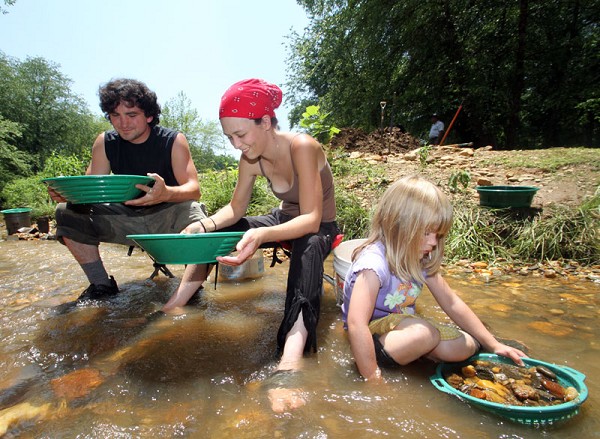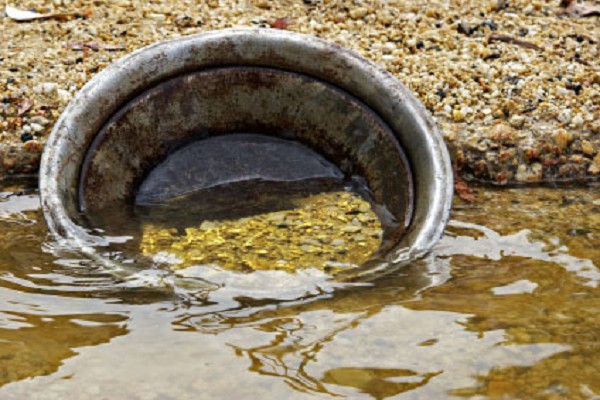
Gold Prospectors Association has family outings in Michigan and five other states. GOLD IN MICHIGAN??? Recalling Mysterious Find by State Geologist Houghton
March 8, 2013
Leave a Comment
|
||||||||||
| Printer Friendly Story View |
Is there really gold in Michigan?
Secret, unverified reports say for centuries, gold, silver, copper and diamonds have been found in northern Michigan.
Michigan Public Radio recently reported that a nondescript campground about 15 miles due south of Battle Creek is one of the centers for gold prospecting in southern Michigan.
US Forest Service records in Cadillac allegedly claim gold has been found in over 100 Michigan locations. Gold has been discovered in 27 of 68 counties in the Lower Peninsula and 6 of 15 counties in the UP, according to these reports.
Forest service reports say prospectors have found gold in the Manistee, Au Sable and other rivers.
How much of this is true remains speculation.
"The one genuine gold mining myth in Michigan goes back to the days of the first State Geologist," wrote Franklin G. Pardee, former state geologist in Michigan Conservation Magazine in 1945.
But apparently gold in Michigan was not a myth.
State Geologist Douglass Houghton left camp one day in the company of an Indian, Pardee recalled.
"Upon returning Houghton carried with him some specimens of rich gold ore. A short time after this Douglass Houghton was drowned and he either did not make any notes of the location of this gold ore, or they were destroyed with him."
The source of this ore never was discovered. Fearing that his men would desert to prospect for gold, he kept the find a secret. Houghton only revealed the discovery to his close associate Samuel Worth Hill, grizzled salty-tongued prospector immortalized in the euphemism "What the Sam Hill!"
But on a stormy night in October 1845, while trying to complete his season's field work before the onset of winter, Houghton risked a dangerous coasting trip in an open boat and was drowned near Eagle River at the age of 36.
Like the Lost Dutchman Mine in Arizona, the secret died with Houghton.
A monument composed of Upper Peninsula rocks stands beside Highway M-26 on the outskirts of the village of Eagle River, a fitting memorial to Michigan's first State Geologist.
Houghton's gold was the first, however, and had he lived and pursued its development, like happened with the more abundant copper, gold may have become a major industry here.
"Houghton's career, brief as it was, made him easily the most distinguished man of his generation in the Lake Superior region," wrote J.R.VanPelt in 1964. Van Pelt became the fifth president of Michigan Technological University where a library is named for him.
"In a few short years he had discovered and mapped the major geologic structures of the area," observed Van Pelt. He had made painstaking "observations of the relation of the copper in the fissures to the other minerals present, and the relation of the fissures to the broader geologic structure.
"He had used his data as the basis for a tentative hypothesis of the origin of the ore bodies. Even in this early day he seemed instinctively to use the methods of research which later became commonplace in the scientific world."
Though diminutive of figure and not very robust of constitution, his keen eyes, his resolute and decisive manner, his boundless energy, and his unswerving devotion to his scientific studies as a tool for developing the region, made him both a natural leader and a great scientist.
"Without doubt this legend contains grains of truth because over $600,000 in gold has been taken from the Ropes Mine in Marquette County, and a spectacular specimen of gold ore from the Michigan Mine in the same locality was exhibited at the 1893 World's Fair in Chicago," wrote Pardee.
There have been many explorations for gold in the hard rocks of the Northern Peninsula, but the early observers who wrote about it were concerned with the gold mining "myths" of the Southern Peninsula.
In 1914, R. C. Allen, then State Geologist, wrote a paper on "Gold in Michigan." After reviewing the gold mines and prospects in the hard rock areas, he listed the reported occurrence of gold in about thirty places in the southern part of the state. All these so-called discoveries were from the sand and gravel beds above the solid rock and represented the location of one or two samples of material containing some small amounts of gold -- for example, a small nugget, or perhaps a few colors in a pan of gravel.
Since that time there have been many other reports of gold found in the glacial drift, but, like the former ones mentioned by Allen, none were commercially important."
The glacial drift of Michigan may carry gold worn off the hard rock hills of northern Michigan and Ontario, but, by the very nature of these glacial deposits, this gold has been scattered and distributed all over the state.
Van Pelt speculated: "It is possible to imagine that somewhere there may be a concentration of gold of commercial importance in the Southern Peninsula, probably along some glacial river bed, but to date no occurrence of this sort has been reported. The chances for a concentration of this character are remote, and it would be like looking for a needle in a haystack."
With no signs of igneous activity of this kind in this part of the state, however, the reporting of gold occurrences in Southern Michigan in large quantities is always looked upon with a great deal of skepticism, according to Van Pelt.
About 1924 the State Geological Survey received reports on an "important gold" occurrence in Alpena County. At first it was thought that someone had hit a pyrite concentration in shale. Pyrite is a mineral that is a brassy yellow, mistaken for gold so often it is called "fool's gold."
When it was determined that gold was reported from the limestone in that area, a careful check was ordered.
Not only was the gold absent in the original rock, but the only real gold found was dental gold forced into the rocks. It took time to bring this condition to light. In the meantime, we had to deal with a "wonderful method" for the extraction of gold.
The chemist for the Alpena group reported a "new process for recovering the extremely finely divided gold" that had been missed in the assays by the best laboratories in the country. This idea of a finely divided gold explained why the gold could not be seen in the rock, and offered a plausible story to the uninformed investors.
Before the smoke blew away, a lot of drilling was done, an experimental mill set up, and a shaft sunk -- expending over $200,000 to get down about 230 feet. This shaft found nothing but a large amount of water and the money spent to sink it had been completely wasted. Furthermore, this expenditure was only about one half of the total sum wasted.
After a year, excitement at Alpena died down. The reports of all the investigations, the lack of funds, and the departure of certain individuals from Michigan all contributed to this end. The "Alpena Rand", appeared to be dead. The economic depression, along with the increase in the price of gold, however, had a marked effect on the renewed search for this metal.
Once the price of gold went up, it became obvious the "Alpena Rand" would revive, but no one anticipated the rash of "gold fields" that were to break out all over the Southern Peninsula.
Gold in great amounts was reported from Vernon, Ortonville, Perry, Montrose, and the Grand Rapids "gold fields." In no place, however, had accurate sampling showhe rash of "gold fields" that were to break out all over the Southern Peninsula.
Gold in great amounts was reported from Vernon, Ortonville, Perry, Montrose, and the Grand Rapids "gold fields." In no place, however, had accurate sampling shown any gold.
The renewal of activity at Alpena was boosted by the report of an engineer claiming to have visited all the large gold fields of the world. "His presumably learned report, when analyzed carefully, consisted of a log of geological terms put together in such a way that they meant absolutely nothing," wrote Van Pelt.
A second engineer with an address on lower Broadway near the financial district of New York City, and a list of previous jobs and titles that made him appear to be a creditable member of the mining profession, emerged. He based his whole report on samples and never visited the so-called gold fields. His report contained what Van Pelt called "a lot of geological double talk" for a stipend of $2,500.
"This chemist left Michigan rather abruptly without leaving a forwarding address. Needless to say, no gold mine has ever been developed in the Alpena area. The money spent in this venture has all been lost. The chemist referred to above was also mixed up in the development of some of the other so-called "gold areas" of the Southern Peninsula.
Van Pelt sardonically concluded: "To say that these assays showing large amounts of gold were due to improper sampling or improper work in the assay office would be charitable."

There's Gold in them there hills.
| Printer Friendly Story View |
|
|

Dave Rogers |
|
|
|
Printer-Friendly Story View
0200 Nd: 04-16-2024 d 4 cpr 0
12/31/2020 P3v3-0200-Ad.cfm
SPONSORED LINKS
12/31/2020 drop ads P3v3-0200-Ad.cfm


